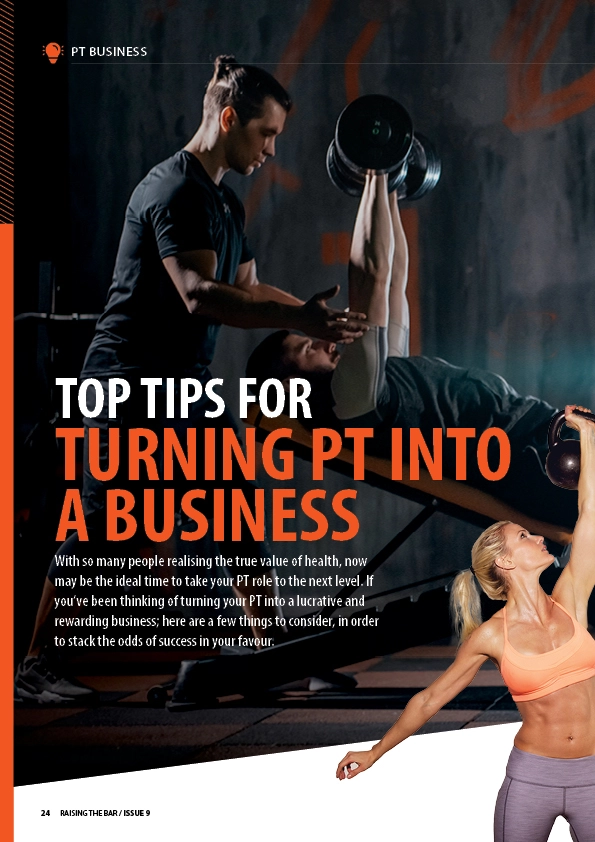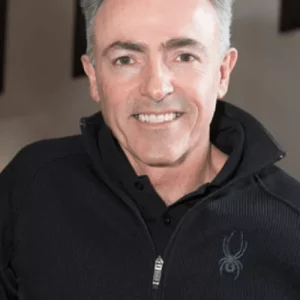pt business
Top Tips for Turning Pt Into A Business

PT VS BUSINESSPERSON
There’s a huge difference between being a great PT and being a good businessperson; and sadly, being an awesome PT doesn’t necessarily mean you’ll be an equally amazing business owner. This is most likely because the number one goal of business is to make enough money to keep the entity viable.
What many aspiring business owners fail to consider when setting up a PT business is that, first and foremost, the ultimate goal is to pay yourself – thousands of businesses fail every year (not just PT businesses), because the owners calculate how much money is required to run the business and often take a small or no salary as part of this. Whilst this might be seen as a noble strategy to adopt in the short term, the problem is that many business owners go for years without being paid appropriately – so all they have done is to dramatically increase the amount of work they need to do (work that is often no fun at all), whilst being paid a fraction of what they were making when working for someone else.
It is vitally important to do a few things when first putting together a financial plan for your aspiring PT business:
Double the length of time it is going to take to secure the clients you need.
Halve the amount of money you are going to make in the first two to three years.
Double the amount of time you will need to spend on and in the business.
Ensure you have enough back-up funds to survive the above changes to your initial business plan.
What often leads to a rapid descent towards business failure is taking out a lease on a property to run your business. Whilst in most cases you do need to have a facility of some sort, everyone will be aware of the rapid turnover of the numerous 24/7 gym franchises that seem to pop up and and then close down with monotonous regularity.
A big mistake is often taking out the lease before you have the clientele in place – I was involved in a Sport High Tech Start Up many years ago and clearly remember the head engineer stating that the technology was so good that we didn’t need to market it – the people would just flock to buy it!!!
Even though the technology was amazing (the now ubiquitous sport GPS units worn by all professional team sport athletes around the world) I basically lived on planes and in hotel rooms as we spent the best part of the first six years of the business convincing the market of the need for this product. All the while we had to raise significant funds on multiple occasions until the business was self-sustaining.
We see this too often with flashy training centres opening and then closing down within 12 to 24 months, due to not being able to make the business model work.
RUNNING THE BUSINESS WITH MINIMAL COSTS
A viable workaround can be renting facilities by the hour – I have a couple of different training centres where I can rent space at a reasonable hourly rate allowing me to bring my clients to a nice centre, with all the equipment I need and with non of the stress of facility ownership.
Sometimes the available hours in this scenario may not be ideal, but I feel this is still a better early stage strategy than jumping into the expense of setting up your own facility only to find out that it isn’t going to work, leaving you are left with a large debt to cover.
You might start with a ‘roving PT business’, which will limit costs to your time and car expenses or working at an established gym whilst slowly growing your own business. Again, you need to be honest with yourself about how successful the business really is before you resign from your ‘day job’ because when you leave the comfort of the regular paycheck, you are then on your own and it will be sink or swim time.
An opportunity that has arisen over the past two years due to the COVID-19 outbreak is running your business online. There are a couple of different models that are generating some success with this model:
- Personalised sessions (one-to-one, or one to many) – I have been running my fitness programs online for a large part of 2021 and whilst not the same as being face to face, it still allows me to touch base with all my clients on a weekly basis, take them through the routines I want them to complete and is a great stop gap until face to face resumes. One particular benefit of this type of training is that you can record the sessions and this allows you to review your performance and make improvements where needed.
- Pre-recorded sessions – These are sessions whereby you actually complete a full session, record and then put this file online for your clients to access (and new clients to purchase or join your group). This is a great way of building up a range of resources that you can make available to clients anywhere in the world.
NICHE MARKET
I often speak to aspiring PTs about what they think their ideal PT business is and very often the majority don’t really have an idea of what market they will try to specialise in. The PT market is incredibly broad and working in a gym is only one small part of the available PT markets available to any aspiring PT entrepreneur.
The fitness market has matured over the past 20 years, so being a generalist is not as lucrative an approach as it once was. Specialisation is the name of the game and as such it is quite important that you think about what aspect of the market you would like to specialise in, and then plan accordingly to enter the market and slice out a piece of this for yourself.
I have often heard from PTs I have spoken to that they would like to work in market X, Y, Z but don’t think there is a large enough market for this type of business – I personally think the mistake is that there are now thousands of PTs all trying to work in the generic PT space making it very competitive and even less likely to be able to create a viable business from this market. A great example of specialisation, a good friend of mine was interested in teaching people to run technically well and aimed to set himself up as the speed guru in town. He has just passed 20 years running his business and makes well over $100,000 per year, working part-time teaching individuals how to run fast!
Another colleague has just started delivering strength and conditioning programs for clients with special needs. It looks like this might turn out to be an instant market with enough clients to make the business model a viable one in a short time frame.
MARKETING YOUR PT BUSINESS
Of all the skills you will need to develop if you want to start and grow a PT business, how to go about marketing yourself is crucial. In the modern age of social media this has become incredibly hard even though the technology has made it relatively simple to get your brand out into the marketplace.
Through the use of Facebook, Google, YouTube, Instagram, TikTok and the like, there are a multitude of avenues to promote your business. And with many of these platforms, it’s not expensive to get an advertising campaign up and running. The biggest challenge is that everyone now has access to these platforms, so there is an overwhelming number of businesses that are promoting themselves, so your challenge is to really separate yourself and your services from the crowd. Of course, this can be made even more challenging, when movie stars/influencers start promoting fitness routines and programs (most are generic and not really suited to anyone!). Don’t think just because you post some good content on to YouTube, for example, that you will suddenly have thousands of subscribers and make lots of money. These platforms have also matured and success on any of them in most cases takes a long time and huge effort for years before any success can be found.
An excellent example is Athlean-X (Jeff Cavaliere) – one of the most successful YouTube PTs in the world – but few would realise that he started his YouTube channel in 2009! He posted training information for years before he achieved any success, and it has only been in the past five years or so, that the business has really taken off.
The maturation of these markets (both PT and online marketing) means that any success story is likely to be one of these overnight successes that took ten or more years to get there!
DO YOU WANT THE STRESS?
I’ve known many PTs who loved what they do, and so went out on their own, only to realise that the fun part was the training and not the running their own business. The majority of these PTs eventually closed down their business (incurring a financial loss), to then return to work for an established fitness centre or leave the industry altogether.
Take heed of my business suggestions and if you have sufficient financial resources, then slowly build up both your clientele, business and marketing efforts. This is the safest way to ensure you maximise your chance of building a successful PT business with longevity.


Adrian Faccioni
Adrian has been involved in Sport and Fitness/Conditioning for over 30 years. He is the brains behind the first globally commercialised Sport GPS device and author of Globally Positioning Sport: Why being first out of the blocks doesn’t guarantee you will win the race! Adrian specialises in working with 40+ year olds through his business Fatch Fitness. Learn more at FatchFitness.com